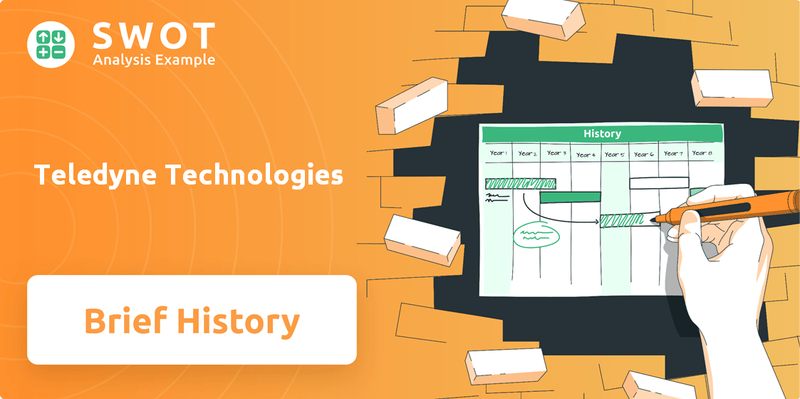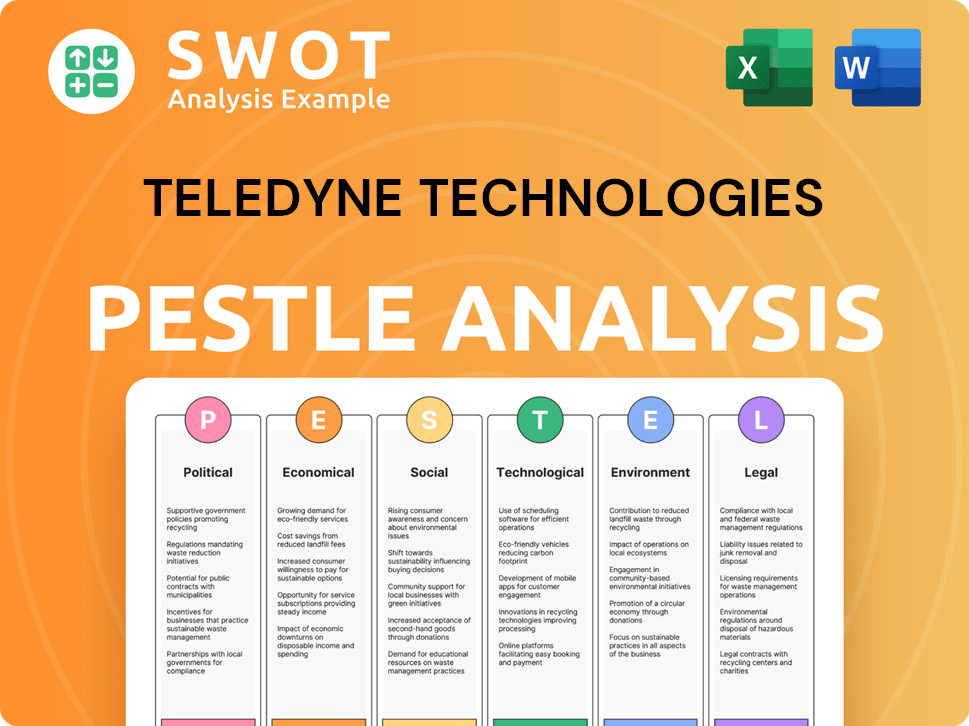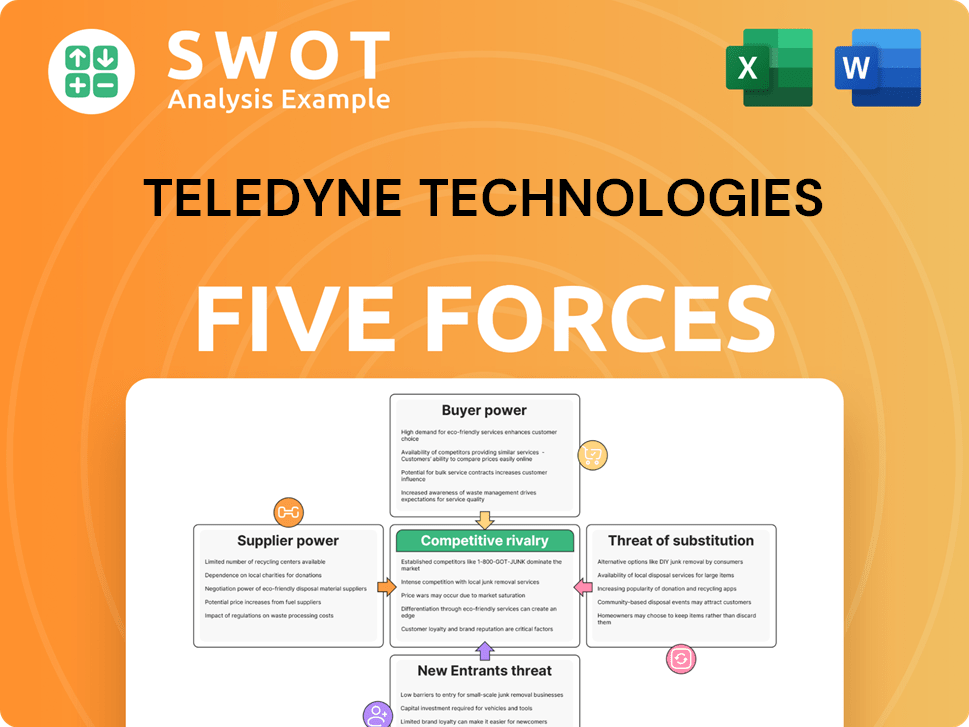Teledyne Technologies Bundle
How has Teledyne Technologies Transformed Since 1960?
Embark on a journey through the remarkable Teledyne Technologies SWOT Analysis, a company that began as a visionary startup and evolved into a global technology powerhouse. Discover the pivotal moments that shaped the Teledyne company, from its inception in the heart of California to its current status as a leader in diverse industrial markets. Uncover the Teledyne history and see how it has consistently pushed the boundaries of innovation.

From its early focus on aerospace and defense to its current diverse portfolio, the Teledyne Technologies story is one of strategic adaptation and growth. This brief history explores the key milestones, including significant Teledyne acquisitions, that have propelled the company forward. Learn about the Teledyne products that have made a significant impact, and how the company has maintained its position in the market through innovation and strategic foresight.
What is the Teledyne Technologies Founding Story?
The story of Teledyne Technologies begins in 1960, a venture spearheaded by Henry Singleton and George Kozmetsky. Their ambition was to build a company focused on technological innovation and strategic acquisitions. This brief history of Teledyne Technologies charts its course from a small startup to a major player in various industries.
Singleton and Kozmetsky, both engineers with experience at Litton Industries, Inc., launched their initial firm, Instrument Systems, in Beverly Hills, California. Financed by a $450,000 investment from venture capitalist Arthur Rock, the company set out to acquire businesses in control systems and microelectronics. This marked the beginning of Teledyne's journey, a company that would become known for its diverse portfolio and strategic approach.
The early years of Teledyne Technologies were defined by strategic acquisitions and a clear vision. The founders aimed to build a diversified technology company through targeted purchases. This approach, coupled with a focus on financial discipline, laid the groundwork for Teledyne's future success.
Teledyne, Inc. was founded in 1960 by Henry Singleton and George Kozmetsky, with initial funding from venture capitalist Arthur Rock. Their strategy centered on acquiring companies in niche technology areas.
- The first acquisition was Amelco, an electronics manufacturing plant, in October 1960.
- The name 'Teledyne' was adopted to signify 'distant force' or 'power from afar.'
- By the end of 1960, Teledyne had approximately 400 employees and nearly $4.5 million USD in sales.
- The company's stock was first offered to the public in May 1961.
Henry Singleton's leadership was crucial in shaping Teledyne's strategy. He emphasized return on assets and employed contrarian investment strategies. This included share buybacks during market downturns, which helped enhance shareholder value. This financial discipline and strategic acquisitions were key to the company's growth.
Teledyne's focus on niche markets and strategic acquisitions has been a consistent theme throughout its history. This approach allowed the company to build a diversified portfolio of businesses, making it a significant player in various sectors. For more details on the company's financial performance and business model, see Revenue Streams & Business Model of Teledyne Technologies.
Teledyne Technologies SWOT Analysis
- Complete SWOT Breakdown
- Fully Customizable
- Editable in Excel & Word
- Professional Formatting
- Investor-Ready Format

What Drove the Early Growth of Teledyne Technologies?
The early years of Teledyne Technologies were marked by rapid expansion and strategic acquisitions. This period saw the company grow significantly through mergers and acquisitions, broadening its capabilities and market reach. These early moves laid the foundation for the diversified conglomerate that Teledyne Technologies would become.
In 1962, Teledyne aggressively pursued growth through acquisitions, primarily using equity agreements. By the end of that fiscal year, the company had acquired a total of 34 companies. This expansion boosted sales to $86 million and generated a net income of $3.4 million, with a workforce of approximately 5,400 employees.
The acquisition of Amelco Semiconductor in 1963 expanded Teledyne's electronics capabilities. In 1966, the acquisition of Ryan Aeronautical marked the company's entry into the aerospace industry, a significant step in its diversification strategy. These acquisitions were crucial in shaping Teledyne's portfolio of Teledyne products.
A notable shift occurred in 1966 when George Kozmetsky left the company. In July 1966, Teledyne merged with Vanadium-Alloy Steel Co. (VASCO), including its subsidiary Allvac, which expanded the company's presence into the Eastern U.S. and initiated material technologies as a major business activity. Henry Singleton continued to drive new acquisitions.
By the end of the 1970s, Teledyne had evolved into a significant conglomerate, acquiring companies like E-Systems, Hamilton Standard, and Litton Industries. At various times, Teledyne, Inc. owned over 150 companies with diverse interests, demonstrating an aggressive diversification strategy. This strategy, driven by Singleton's capital allocation principles, enabled Teledyne to consistently outperform the market.
Teledyne Technologies PESTLE Analysis
- Covers All 6 PESTLE Categories
- No Research Needed – Save Hours of Work
- Built by Experts, Trusted by Consultants
- Instant Download, Ready to Use
- 100% Editable, Fully Customizable

What are the key Milestones in Teledyne Technologies history?
The Teledyne Technologies brief history is marked by significant strategic shifts and technological advancements. A key turning point was the spin-off from Allegheny Teledyne in November 1999, establishing Teledyne Technologies as an independent entity focused on high-technology markets. Under Robert Mehrabian's leadership, the company strategically concentrated on core segments, driving its evolution and expansion.
| Year | Milestone |
|---|---|
| 1999 | Spin-off from Allegheny Teledyne, establishing Teledyne Technologies as a separate public company. |
| 2000 | Robert Mehrabian becomes Chairman, President, and CEO, shaping the company's strategic direction. |
| 2023-2025 | Strategic acquisitions including Xena Networks (Oct 2023), Adimec Imaging (Feb 2024), Micropac (Dec 2024), and Qioptiq (Jan 2025), expanding the company's portfolio. |
Teledyne Technologies has consistently been at the forefront of innovation, particularly in digital signal processing. Recent advancements include imaging sensors used to detect galaxies 13.4 billion light-years away and providing critical components for the Curiosity Rover on Mars. In March 2025, Teledyne launched the world's first configurable 3U VPX Power Supply Card for LEO Satellites, and in February 2025, they unveiled a wideband 50 GHz RF Switch for Aerospace and Defense applications.
Early pioneer in digital signal processing technology, which has been crucial for many of its products.
Developed imaging sensors capable of detecting galaxies 13.4 billion light-years away, showcasing its advanced technological capabilities.
Supplied critical components for the Curiosity Rover on Mars, demonstrating its role in space exploration.
Launched the world's first configurable 3U VPX Power Supply Card for LEO Satellites in March 2025, expanding its reach in the aerospace sector.
Unveiled a wideband 50 GHz RF Switch for Aerospace and Defense applications in February 2025, enhancing its product offerings.
Teledyne FLIR, a key part of its digital imaging segment, is recognized for its thermal imaging cameras.
Teledyne Technologies has faced challenges, including increased competition due to patent expirations, such as the U.S. patent for its Wireless GroundLink product in 2018. Additionally, some customers have developed competing products or opted for vertical integration, affecting market dynamics. However, Teledyne's diversified business model, with substantial contributions from commercial and government sectors, has been a key driver of its performance, supporting a five-year revenue CAGR of 12%. For more insights, you can explore the Competitors Landscape of Teledyne Technologies.
The expiration of patents, such as the U.S. patent for its Wireless GroundLink product in 2018, led to increased market competition.
Some customers have developed competing products or opted for vertical integration, which has impacted market dynamics.
Teledyne's diversified business model, with contributions from both commercial and government sectors, has been a key driver of its performance.
The company's strategic response to challenges often involves targeted acquisitions, such as Xena Networks (October 2023), Adimec Imaging (February 2024), Micropac (December 2024), and Qioptiq (January 2025).
Teledyne's diversified business model has supported a five-year revenue CAGR of 12%.
Teledyne FLIR has delivered approximately 30,000 Black Hornet nano-drones to security forces in over 40 countries.
Teledyne Technologies Business Model Canvas
- Complete 9-Block Business Model Canvas
- Effortlessly Communicate Your Business Strategy
- Investor-Ready BMC Format
- 100% Editable and Customizable
- Clear and Structured Layout

What is the Timeline of Key Events for Teledyne Technologies?
The Teledyne Technologies story is one of strategic evolution and technological advancement. Founded in 1960 by Henry Singleton and George Kozmetsky, the company quickly expanded through acquisitions, entering the aerospace industry in 1966 with the purchase of Ryan Aeronautical. A significant restructuring occurred in 1996 when Teledyne, Inc. merged with Allegheny Ludlum, followed by the spin-off of Teledyne Technologies as an independent entity in 1999. Under the leadership of Robert Mehrabian, who became Chairman, President, and CEO in 2000, the company continued to grow, with recent acquisitions like Micropac and Qioptiq. The company's history is a testament to its adaptability and commitment to innovation, particularly in the aerospace and defense sectors.
| Year | Key Event |
|---|---|
| 1960 | Teledyne, Inc. is founded by Henry Singleton and George Kozmetsky. |
| 1963 | Acquisition of Amelco Semiconductor, expanding electronics capabilities. |
| 1966 | Acquisition of Ryan Aeronautical, entering the aerospace industry. |
| 1999 | Teledyne Technologies is spun off as an independent public company from Allegheny Teledyne. |
| 2000 | Robert Mehrabian becomes Chairman, President, and CEO of Teledyne Technologies. |
| 2024 | Teledyne completes the acquisition of Micropac. |
| 2025 | Teledyne acquires Qioptiq. |
| 2025 | Teledyne appoints George Bobb as Chief Executive Officer. |
Teledyne Technologies anticipates continued margin improvements and strong cash flow in 2025. The company projects GAAP EPS between $17.35 and $17.83, and non-GAAP EPS between $21.10 and $21.50. Expected sales are projected to reach approximately $6 billion, reflecting robust financial health and growth potential. These figures demonstrate the company's strong financial outlook and strategic planning.
Teledyne is focused on expanding its business through targeted acquisitions and product development. This strategy emphasizes growth in its four business segments: Instrumentation, Digital Imaging, Aerospace and Defense Electronics, and Engineered Systems. Recent acquisitions, such as Micropac and Qioptiq, highlight the company's commitment to strengthening its market position and broadening its product offerings within key sectors.
Analysts are bullish on Teledyne Technologies, with price targets ranging up to $600. This positive outlook reflects confidence in the company's acquisition pipeline and margin resilience. The company's focus on markets with high barriers to entry and specialized products positions it well for continued success, supported by strong financial performance and strategic expansion.
Teledyne Technologies continues to invest in innovation, as demonstrated by recent product launches such as the Wideband 50 GHz RF Switch and the configurable 3U VPX Power Supply Card. These advancements highlight the company's commitment to providing enabling technologies for demanding applications. You can find more details about the company's journey in this article on the brief history of Teledyne Technologies.
Teledyne Technologies Porter's Five Forces Analysis
- Covers All 5 Competitive Forces in Detail
- Structured for Consultants, Students, and Founders
- 100% Editable in Microsoft Word & Excel
- Instant Digital Download – Use Immediately
- Compatible with Mac & PC – Fully Unlocked

Related Blogs
- What is Competitive Landscape of Teledyne Technologies Company?
- What is Growth Strategy and Future Prospects of Teledyne Technologies Company?
- How Does Teledyne Technologies Company Work?
- What is Sales and Marketing Strategy of Teledyne Technologies Company?
- What is Brief History of Teledyne Technologies Company?
- Who Owns Teledyne Technologies Company?
- What is Customer Demographics and Target Market of Teledyne Technologies Company?
Disclaimer
All information, articles, and product details provided on this website are for general informational and educational purposes only. We do not claim any ownership over, nor do we intend to infringe upon, any trademarks, copyrights, logos, brand names, or other intellectual property mentioned or depicted on this site. Such intellectual property remains the property of its respective owners, and any references here are made solely for identification or informational purposes, without implying any affiliation, endorsement, or partnership.
We make no representations or warranties, express or implied, regarding the accuracy, completeness, or suitability of any content or products presented. Nothing on this website should be construed as legal, tax, investment, financial, medical, or other professional advice. In addition, no part of this site—including articles or product references—constitutes a solicitation, recommendation, endorsement, advertisement, or offer to buy or sell any securities, franchises, or other financial instruments, particularly in jurisdictions where such activity would be unlawful.
All content is of a general nature and may not address the specific circumstances of any individual or entity. It is not a substitute for professional advice or services. Any actions you take based on the information provided here are strictly at your own risk. You accept full responsibility for any decisions or outcomes arising from your use of this website and agree to release us from any liability in connection with your use of, or reliance upon, the content or products found herein.